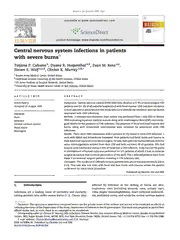
DTIC ADA629397: Central Nervous System Infections in Patients with Severe Burns PDF
Preview DTIC ADA629397: Central Nervous System Infections in Patients with Severe Burns
Report Documentation Page Form Approved OMB No. 0704-0188 Public reporting burden for the collection of information is estimated to average 1 hour per response, including the time for reviewing instructions, searching existing data sources, gathering and maintaining the data needed, and completing and reviewing the collection of information Send comments regarding this burden estimate or any other aspect of this collection of information, including suggestions for reducing this burden, to Washington Headquarters Services, Directorate for Information Operations and Reports, 1215 Jefferson Davis Highway, Suite 1204, Arlington VA 22202-4302 Respondents should be aware that notwithstanding any other provision of law, no person shall be subject to a penalty for failing to comply with a collection of information if it does not display a currently valid OMB control number 1. REPORT DATE 2. REPORT TYPE 3. DATES COVERED 01 AUG 2010 N/A - 4. TITLE AND SUBTITLE 5a. CONTRACT NUMBER Central nervous system infections in patients with severe burns 5b. GRANT NUMBER 5c. PROGRAM ELEMENT NUMBER 6. AUTHOR(S) 5d. PROJECT NUMBER Calvano T. P., Hospenthal D. R., Renz E. M., Wolf S. E., Murray C. K., 5e. TASK NUMBER 5f. WORK UNIT NUMBER 7. PERFORMING ORGANIZATION NAME(S) AND ADDRESS(ES) 8. PERFORMING ORGANIZATION United States Army Institute of Surgical Research, JBSA Fort Sam REPORT NUMBER Houston, TX 9. SPONSORING/MONITORING AGENCY NAME(S) AND ADDRESS(ES) 10. SPONSOR/MONITOR’S ACRONYM(S) 11. SPONSOR/MONITOR’S REPORT NUMBER(S) 12. DISTRIBUTION/AVAILABILITY STATEMENT Approved for public release, distribution unlimited 13. SUPPLEMENTARY NOTES 14. ABSTRACT 15. SUBJECT TERMS 16. SECURITY CLASSIFICATION OF: 17. LIMITATION OF 18. NUMBER 19a. NAME OF ABSTRACT OF PAGES RESPONSIBLE PERSON a REPORT b ABSTRACT c THIS PAGE UU 4 unclassified unclassified unclassified Standard Form 298 (Rev. 8-98) Prescribed by ANSI Std Z39-18 burns 36 (2010) 688 691 689 (CNS)[2].CNSinfectionsinpatientswithoutburns,suchas 3. Results bacterial meningitis, are typically community onset with infections due to Streptococcus pneumoniae and Neisseria ThetotalnumberofadmissionstotheBurnUnitforthermal meningitis. In the case of head trauma resulting in shunts burns was 1964 with 694 patients from Operation Enduring ordirectCNSpenetration,nosocomialinfectionscanoccur Freedom/OperationIraqiFreedom,97.8%malesandamedian with gram negative organisms (over 50% of cases) such as ageof38(range19 52).Ofthe1270civilianandmilitary(not Pseudomonas aeruginosa and Acinetobacter, and also Staphylo Operation Iraqi Freedom/Operation Enduring Freedom) coccus species (25% of cases) [4 6]. The rate of developing patients,78.8%weremaleswithasoverallmedianageof54 nosocomial meningitis is rare in the hospital without (range11 96).Fromalladmissions,12patientshadsuspected antecedentheadtraumaorpriorinfection[7,8].Burnreviews CNSinfectionsbychartreview,ofwhom2patients(0.1%ofall have reported facial burns and head trauma as being burn admissions)werenoted to have bacteria isolatedfrom associated with CNS infection [4]. There are several case theirCSFculture,confirmingCNSinfection(Table1).Bothof reports that correlate burns with brain abscesses [9]; these patients were Operation Iraqi Freedom/Operation however, incidence and etiologies are not known. A post Enduring Freedom soldiers who had sustained facial burns mortem study examining CNS complications of thermal andheadtraumarequiringintracranialsurgerywithcraniec burnsfrom1992reported10.1%ofcaseswithbrainabscess; tomies. In addition, both patients had bacteremia with however,thisfindingwasnotpresentinamorerecentburn identical microorganisms as isolated from CSF (Acinetobacter autopsy review [2]. Current published literature is not baumannii and methicillin resistant Staphylococcus aureus available and prior literature fails to identify incidence (MRSA). andrateofCNSinfectioninassociationwiththermalburns Ofallpatientswithburnswhowereadmitted,560(28.5%) and head injury. We set out to find the incidence of CNS hadheadornecktraumaandburns.Twenty sevenpatients infections in a burn unit and identify any associated risk (4.8%ofallthosewithheadorneckburns)alsohadheador factors,includingfacialburnsorCNStrauma. necktrauma.Of1964patientsadmitted,only0.1%hadaCNS infection, 100% of whom also had trauma and burns to the headandneckandweresoldiers.Onehundredandtwenty 2. Methods five patients had a surgical procedure to either harvest the scalpordebridethescalpinthesettingofscalpburns,outof TheUSArmyInstituteofSurgicalResearchBurnCenterisa40 which 9 patients had an invasive surgical procedure that bed burn unit which serves both Department of Defense involvedpenetrationoftheskull.Fouroutofthose9patients, beneficiaries,includingcasualtiesfromthewarsinIraqand receivedcraniectomiesand5patientshadtrephinationofthe Afghanistan, and a local civilian population from southern skullduringtheprocessofdebridement.Outof125patients Texas.Burnpatientcareconsistsofaggressiveresuscitation withsurgicalproceduresofthehead,onlytwopatients,who uponarrivalwithearlywounddebridementandskingrafting. underwent craniotomies, had evidence of CNS infections. Intravenous perioperative antibiotics are administered to Therefore, scalp harvesting donor sites did not pose an patientsundergoingsurgicalprocedures,andtypicallyconsist increasedriskfordevelopmentofCNSinfections. ofvancomycinandamikacin.Topicalantimicrobialtherapies are applied to the burns, the selection of which is at the discretionoftheattendingphysician.Allpatientshavecentral 4. Discussion venous access with routine replacement of central lines, typically every 3 days. Patients are cared for in individual Infectionsaretheleadingcauseofmortalityinpatientswho rooms under contact precautions during their entire hospi sustainsevereburns[1 3].Multiplefactorsareassociatedwith talization. propensityofinfectioninburnedpatient.Extensivedestruc Duringtheperiodof1July2003to30June2008,inpatient tionofprotectivecutaneousbarrier,presenceofnecroticand electronicmedicalrecordswerescreenedforthepresenceof edematous tissues which tend to harbor microorganism CNSinfectioninburnpatientsandtheclinicalmicrobiology growth, use of equipment for invasive monitoring during records were screened for anyone with a culture obtained resuscitation, and impaired immunity are just a few con from the CNS or from cerebrospinal fluid (CSF). Medical tributingfactorstoinfection[10].Thisstudywasdesignedto recordswerereviewedforpatientdemographics(age,gender, describetheincidenceofCNSinfectionsinthesettingofburns mechanism of injury, site of injury, injury as a result of and associated risk factors as current data is lacking in the military operations), percentage of total body surface area literature.Ourstudyrevealsaverylowrateof0.1%forallburn burnaswellasfullthicknessburnsandbodyregionofburn. patients,andlowrateseveninpotentiallyhigherriskpatient, Evidence of polytrauma was identified in individual burn populations,includingthosewithfacial/headburns(0.35%)or patients and all patients with facial or head injuries were directheadtrauma(1.3%),buthighrate(22.2%)ifthecranium identified. Patients with neurosurgical procedures or any waspenetrated. surgical procedure involving penetration of the skull, were Bacterial CNS infections (meningitis) are associated with identified. CSF gram stains, cultures and antibiotic therapy significantmortalityandmorbidity,withthemajorityofacute (both systemic and intrathecal), as well as duration of meningitiscasesinthecommunityduetoS.pneumoniaeand antibiotictherapywerereviewed.CNSinfectionwasdefined Neisseriameningitidis,withanincidenceof2 3/100,000[2,11].Of asoneormorepositiveCSFortissuecultures,withisolationof all meningitis, the incidence of nosocomial meningitis is specificmicroorganisms. reportedtobeapproximately60%[12].Approximately30%of burns 36 (2010) 688 691 691 patientswithCNSinfectionswereOperation IraqiFreedom/ [5] TangL,ChenS,HsuW,LyuR.Acutebacterialmeningitisin Operation Enduring freedom soldiers who sustained head adults:ahospital basedepidemiologicalstudy.QJMed 1999;92:719 25. traumaandunderwentinvasiveintracranialproceduresthat [6] RamosL,CastedoJ,GalvanR,Garc´ıaC,IribarrenJ,Jime´nez involved penetration of the skull, CNS infections were not J.Incidenceofnosocomialinfectioninpatientswith identifiedinthecivilianpopulationthatwasincludedinthe nontraumaticortraumaticcoma.CritCare2008;12:12. study. [7] WeisfeltM,vandeBeekD,SpanjaardL,deGansJ. IntheabsenceofsystematicallycollectedCSFonpatients Nosocomialbacterialmeningitisinadults:aprospective withsystemicinfections,itisnotpossibletocorrelatewhether seriesof50cases.JHospitInfect2007;66:71 8. [8] LeferingR,PaffrathT,LinkerR,BouillonG,NeugebauerE. systemicongoinginfectionsareassociatedwithconcomitant Headinjuryandoutcome whatinfluencedoconcomitant CNSinfectionsorwhethertheseinfectionswereclearedwith injurieshave?JTrauma2008;65:1036 44. antibiotictherapy. [9] SuzukiT,UekiI,IsagoT,NozakiM,HirayamaT,Kawanami Inconclusion,CNSinfectionsinburnpatientsareveryrare O.Multiplebrainabscessescomplicatingtreatmentofa andcompriseofonly0.1%patientswithburnsand0.35%of severeburninjury:anunusualcasereport.JBurnCare patients with head/neck burns. However, in the small Rehab1992;13:446 50. numbersinwhomtheskullwaspenetratedduringasurgical [10] AnserminoM,HemsleyC.ABCofburns:intensivecare managementandcontrolofinfection.BMJ2004;329: procedure22%ofthepatientsbecameinfected.Understand 221 3. ingtheincidenceofCNSinfectionsinburnpatientsprovides [11] HusseinAS,ShafranSD.Acutebacterialmeningitisinadults: guidelines for preventative, diagnostic and therapeutic a12yearreview.Med(Baltimore)2000;79:360 8. actionsandaddressstrategiestoimproveoverallburncare. [12] KhwannimitB,ChayakulP,GeaterA.Acutebacterial meningitisinadults:a20yearreview.SEAsianJTropMed 2004;35:886 92. Conflict of interest [13] O’SheaM,CrandonI,HardingH,DonaldsonG,BruceC, EhikhametalorK.Infectionsinneurosurgicalpatients admittedtotheintensivecareunitattheUniversity Theauthorshavenoconflictofinteresttoreport. HospitaloftheWestIndies.WIndMedJ2004;53:159 63. [14] PednonomosM,TsirantonakiM,PsomaG,KatsarelisN, references KoukoulitsiosG,LafazanosS.Earlyandlateonset nosocomialinfectionsinICUpatientswithheadinjury.Crit Care2006;10:99. [15] VartzeliP,YiambidesA,DaskalakisK,MoukasM,Schulpis [1] RessnerR,MurrayC,GrffithM,RasnakeMS,Hospenthal K,MandragosK.Comparativestudyoninfectionofthe DR,WolfSE.Outcomesofbacteremiainburnpatients centralnervoussysteminpatientswithheadtraumaand involvedincombatoperationsoverseas.JAmCollSurg spontaneouscerebralhemorrhage.CritCare2008;12:13. 2008;206:439 44. [16] NgJ,GosbellIB,KellyJA,BoyleMJ,FergusonJK.Cureof [2] GomezR,MurrayC,HospenthalD,CancioC,RenzE, multiresistantAcinetobacterbaumanniicentralnervous HolcombJ,etal.Causesofmortalitybyautopsyfindingsof systeminfectionswithintraventricularorintrathecal combatcasualtiesandcivilianpatientsadmittedtoaburn colistin:caseseriesandliteraturereview.JAntimicrob unit.JAmCollSurg2009;208:348 54. Chemother2006;58:1078 81. [3] D’AvignonL,SaffleJ,ChungK,CanacioL.Preventionand [17] AlbrechtMC,GriffithME,MurrayCK,ChungKK,Horvath managementofinfectionsassociatedwithburnsinthe EE,WardJA,etal.ImpactofAcinetobacterinfectionon combatcasualty.JTrauma2008;64:277 86. themortalityofburnpatients.JAmCollSurg2006;203: [4] WinkelmanM,GallowayP.Centralnervoussystem 546 50. complicationsofthermalburnsapostmortemstudyof139 [18] BleckTP, Nosocomial, Meningitis. Clin Infect Dis patients.Med(Baltimore)1992;71:271 83. 2007;9:1 2.
